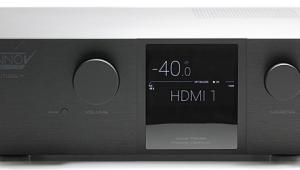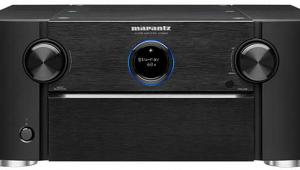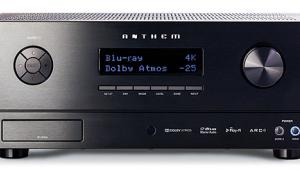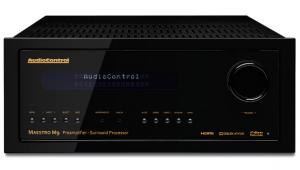Marantz AV8003 Processor and MM8003 Amplifier HT Labs Measures
Marantz AV8003 Processor
Analog frequency response in Pure Direct mode:
–2.38 dB at 10 Hz
–0.74 dB at 20 Hz
–0.17 dB at 20 kHz
–1.09 dB at 50 kHz
Analog frequency response with signal processing:
–2.45 dB at 10 Hz
–0.76 dB at 20 Hz
–0.31 dB at 20 kHz
–47.53 dB at 50 kHz
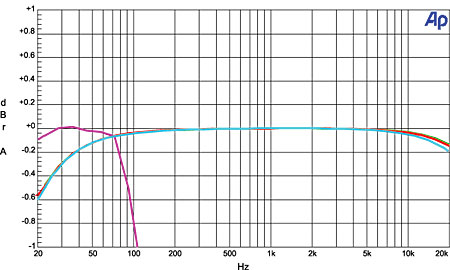
The above chart shows the frequency response of the left (aqua), center (green), LFE (purple), and left surround (red) channels at the preamp outputs of the Dolby Digital decoder. The left channel measures –0.60 decibels at 20 hertz and –0.16 dB at 20 kilohertz. The center channel measures –0.58 dB at 20 Hz and –0.14 dB at 20 kHz, and the left surround channel measures –0.59 dB at 20 Hz and –0.15 dB at 20 kHz. The LFE channel, normalized to the level at 40 Hz, is –0.06 dB at 20 Hz, reaches the upper –3-dB point at 117 Hz, and reaches the upper –6-dB point at 120 Hz.
Response from the multichannel input to the main output measures –2.01 dB at 10 Hz, –0.63 dB at 20 Hz, –0.14 dB at 20 kHz, and –0.91 dB at 50 kHz. The analog THD+N is less than 0.023% at 1 kHz with a 100-millivolt input and the volume control set to +2.0. Crosstalk with a 100-mV input was –87.35 dB left to right and –86.48 dB right to left. The signal-to-noise ratio with a 100-mV input from 10 Hz to 24 kHz with “A” weighting was –122.19 dBrA.—MJP
Video Test Bench
The Marantz AV8003 utilizes an Anchor Bay Technologies (ABT) video processor. These are the same people responsible for the popular DVDO line of outboard video processors. Unfortunately, the AV8003 does not process HD signals. It passes them through but doesn’t perform deinterlacing of 1080i sources. Standard-definition processing was limited to 3:2 pulldown for film-based content and full-motion adaptive support for video-based content, but the processor could not handle film-based content flagged with a 2:2 cadence. This accounts for a small amount of content on the market, though. Analog-to-digital conversion of HD sources resulted in a clear loss of vertical resolution, which will impair fine detail. Scaling of digital and analog SD sources was quite good, though, and in line with the better processors I’ve seen. I was also happy to see the inclusion of a passthrough option for the HDMI output, which allows the user to completely bypass the video processor with high-resolution content if desired.
Marantz MM8003 Amplifier
All channels driven continuously into 8-ohm loads:
0.1% distortion at 109.7 watts
1% distortion at 122.3 watts
Frequency response:
–0.19 dB at 10 Hz
–0.05 dB at 20 Hz
–0.04 dB at 20 kHz
–2.72 dB at 50 kHz
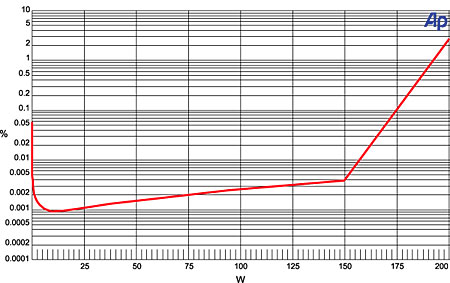
This graph shows that the MM8003’s left amplifier channel, with two channels driving 8-ohm loads, reaches 0.1 percent distortion at 174.8 watts and 1 percent distortion at 192.5 watts. Into 4 ohms, the amplifier reaches 0.1 percent distortion at 248.0 watts and 1 percent distortion at 289.1 watts. An input level of 103.2 millivolts was required to produce an output of 2.83 volts into an 8-ohm load, indicating an overall gain of +28.79 decibels using the RCA input. Using the XLR input, a level of 196.2 millivolts was required to produce an output of 2.83 volts into an 8-ohm load, indicating a gain of +23.21 decibels.
THD+N from the amplifier was less than 0.007 percent at 1 kilohertz when driving 2.83 volts into an 8-ohm load using the RCA input. When using the XLR input under the same conditions, THD+N was less than 0.009 percent. Crosstalk at 1 kHz driving 2.83 volts into an 8-ohm load was –75.48 dB left (channel 1) to right (channel 2) and –75.82 dB right to left using the RCA inputs and –75.04 dB left to right and –75.41 dB right to left using the XLR inputs. These poor results prompted measuring the crosstalk between channels at opposite ends of the chassis, which resulted in –96.30 dB left (channel 1) to “option” (channel 8) and –95.95 dB option to left using the RCA inputs and –99.67 dB left to option and –100.57 dB option to left using the XLR inputs. The signal-to-noise ratio with 2.83 volts driving an 8-ohm load from 10 hertz to 24 kHz with “A” weighting was –114.34 dBrA using the RCA input and –103.05 using the XLR input.—MJP
- Log in or register to post comments

